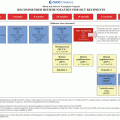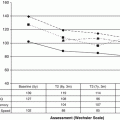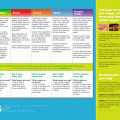Started in 2010
Further explanation
Children cannot be denied coverage for a preexisting condition or no one (adults and children) can be dropped from coverage if they or their guardians become sick
Children with pre-existing conditions can no longer be denied coverage. Individuals of all ages denied a policy because of health conditions, and who have been uninsured for 6 months, can immediately get coverage through high-risk insurance pools, an option that was not previously available in all 50 states. Insurers cannot drop an individual’s health coverage if he/she gets seriously ill or hurt
Needed care must be covered if survivor becomes ill
Insurers are banned from putting a lifetime cap on the amount they will pay for an individuals care and any annual caps must be approved by the Secretary of Health and Human Services. Annual caps will be prohibited by 2014
Children can stay on parent’s policy until they turn 26 years old
Insurers must allow dependent children to remain on their parent’s health care policy (if a family plan) until they turn 26 years of age, whether they are in school or not
Preventive care must be covered at 100 % without out-of-pocket cost to the insured
Health care plans must cover preventive services recommended by the U.S. Preventive Services Task Force or mandated by the Secretary of Health and Human Services, without co-pay or out-of-pocket costs
Insurance companies must justify rate increases
All insurance companies are required to go through a review process to justify rate increases. Beginning in 2014, if a rate is found to be unjustified, the company can be prevented from selling coverage in the insurance exchange
Incentives to increase number of primary care doctors and practitioners
The Federal government is authorized to make new investments to help increase the number of primary care and preventive care providers, including doctors, nurses, nurse practitioners and physician assistants. However, these funds need to appropriated (provided) by Congress every year
Insurance companies must spend most of your premiums on health care services
All insurers that offer large group policies (businesses with more than 50 employees) have to spend at least 85 % of the premiums they collect on health care. For individual and small group policies, they must spend at least 80 % of premiums on care. If these conditions are not met, the insurers must rebate the difference to those they covered the next year. This is one of the tools to help keep premiums from rising
Additional benefits added until full enforcement in 2014
Adults as well as children cannot be denied coverage for a preexisting condition or dropped from coverage if they or their guardians become sick
Individuals of all ages with pre-existing conditions can no longer be denied coverage
Incentives for employers to maintain health coverage of employees
Companies with more than 50 full-time employees will pay a $2,000 fee for each full-time employee not offered health coverage (businesses do not have to pay the fee on the first 30 employees not covered). The fee would then help employees to buy their own individual policy in the insurance ‘shopping mall,’ or exchange
Enhanced options for employed individuals to obtain health coverage
Employees whose employer’s based health care policy costs 8 % or more of their salary, will have the option of buying their own coverage and the employer must provide a voucher to use for this, that is equal to the amount they would have spent on the individual’s health insurance premium. If the cost of the insurance is 9.5 % of your salary or more and your income is below a certain level, you will also get a tax credit to help you purchase insurance in the exchange. (These rules apply only to employees of firms with 50 or more employees
Increased options for health coverage for those unemployed
Beginning in 2014, if you are laid off from your job, you may buy a good policy for you or your family through their state’s insurance exchange (earlier if your state creates an exchange sooner). If you have very low income, you can get coverage from Medicaid
Increased pay to primary care providers seeing Medicaid patients in order to ensure that enough doctors are available to see this population
The federal government will pick up 100 % of the new costs of the incentives for 2 years starting in 2013
Requires all Americans to have health care coverage ensuring that prices are kept down
This will spread the cost of health care amongst those among the entire population and prevents people from purchasing health coverage only when they are sick or believe they are at higher risk of being sick. Having insurance will also discourage use of the highest cost providers or delaying care until the most expensive treatments are needed
Requires companies to compete for your business using uniform criteria
Allows consumers to more easily compare different health care plans
Other benefits of PPACA already in effect include provisions for obtaining appropriate preventive survivorship care [93]. Although not specifically addressing the Children’s Oncology Group late-effects guidelines, insurance plans must provide coverage for all preventive services recommended by the United States Preventive Services Task Force, without out-of-pocket costs. Insurance coverage or payment for a particular service can no longer be denied due to a preexisting condition. Prior to health care reform, insurers could have denied coverage for services to treat conditions that might have been a late effect of a survivor’s childhood cancer treatment or in fact completely dropped the survivor’s insurance once such an event occurred, whether or not the condition was in fact related to the history of cancer. Additionally, PPACA banned lifetime caps on reimbursement of needed care in 2010 and currently any yearly caps must be approved by the Secretary of Health and Human Services. By 2014, yearly limits will be prohibited.
In terms of publically supported health insurance, PPACA reforms included expanding eligibility and improving services provided, with more changes to come with full implementation of the act. For those denied a policy because of health and who had been uninsured for at least 6 months, expanded high risk pools were initiated in June 2010. In terms of quality of care provided, beginning in 2011, federal payments to states were increased for low-income patients with more than one chronic condition in which care is coordinated through medical homes. A routine source of care has repeatedly been shown to increase the likelihood of preventive services and physician visits [97, 98]. A medical home, however, is not just a routine source of care but expands it to the ideal that the care provided is continuous, comprehensive, family-centered, coordinated, and culturally-effective [93]. Despite this fact and that the American Academy of Pediatrics and the U.S. Maternal and Child Health Bureau recommends that all children with special health care needs (CSHCNs) receive care through a medical home, only 50 % of them did so in 2007 [99]. Of particular importance to survivors and other CSCHNs is that medical homes can reside in subspecialty practices as well as primary care practices [93, 100].
Full implementation of PPACA is scheduled for 2014 and will include additional benefits. Employers with more than 50 full time employees, which do not offer health insurance will have to pay a fee of $2,000 to subsidize the cost of their employees obtaining their own policies. If such an employer offers a plan but it is greater than 8 % of an employee’s salary, the company will have to provide a voucher to the employee for the same amount the company would have spent and allow the employee to look for their own insurance. Additionally, individuals who make under a certain amount to be determined and whose cost of employer health insurance is greater than 9.5 % of their salary will also be eligible for tax credits to help them purchase health coverage. However, those employed by companies with 50 or less employees will be covered by different rules, and small businesses will be offered assistance to provide their workers with health insurance.
Even with the passage of PPACA, there will still be barriers for survivors to accessing quality follow-up care, including some which may be exacerbated by PPACA. The first is that PPACA is not yet fully implemented or funded and there are already serious efforts to overturn, repeal, or limit the funding to implement PPACA. Funding for implementing and maintaining PPACA is likely to be a contentious annual issue at least in the near future. Even if fully implemented it is estimated that about 8 % of the population will remain uninsured [101]. Lack of funding will also worsen the issue of a lack of sufficient primary care physicians, because even without the expansion of health insurance coverage through PPACA, a shortage of such providers already exists. Not only might this make it more difficult for survivors to find a PCP who has an opening in their practice, but such providers will be even more challenged to devote the time necessary to learn about and address the special health care issues relevant to the survivors specific history of cancer and its therapy. PPACA does not guarantee access to the Children’s Oncology late effects nor other specialty recommended screening tests. Nor does it guarantee access to academic health centers, where most of the few adult survivorship programs exist, let alone the national experts on a particular topic, which may be necessary considering the rarity and lack of knowledge of some serious late effects of childhood cancer therapy. Nevertheless, the improved access to health care provided by PPACA, and in particular access to generally recommended age- and gender-based screening tests without out-of-pocket costs, represent progress. This piece of legislation also provides a base from which survivors and other populations with special health care needs can use to advocate for specific policies to better address their particular challenges regarding obtaining optimal health care. For example, survivors and their providers could join together to lobby for changes in PPACA to support the adequate reimbursement for the development of individualized cancer care plans and treatment summaries, which allow oncologists to facilitate the coordination of care in a manner described and endorsed by the Institute of Medicine’s National Cancer Policy Board [48].
29.5 Conclusions
The last 40 years has not only seen a dramatic increase in the survival of most childhood cancers but a great amount has been learned about the potential adverse late effects of the powerful therapies that have lead to cures for so many children. Although much work remains to be done to better apply the knowledge-as extensively reviewed in this book—gained about late effects to specific childhood cancer survivors, an additional and just as critical element of ensuring that childhood cancer survivors receive ideal follow-up care is learning and overcoming the disparities and barriers to accessing quality late effects care. In this chapter we have reviewed these disparities and barriers using the IOM model of barriers to quality care in the general population (Sect. 29.1) and Oeffinger’s model of optimal healthcare for pediatric cancer survivors (Sect. 29.2) [5]. Both models divide factors that either facilitate or impede optimum access into long-term care into survivor-related, physician-related and health systems-related categories.
Survivor related factors include issues specific to an individual’s cancer experience but also factors independent of having cancer, such as gender, culture, and education, though in some cases they could be influenced by the cancer experience. In terms of general individual barriers to accessing quality care, little work has been done to investigate these specifically in the childhood cancer survivor population; therefore, the majority of data related to race/ethnicity, culture, and language comes from the general adult literature on barriers and disparities in access to care, including research on primary and secondary cancer screening. This is in contrast to survivor-specific and provider-related domains where the literature in children on survivorship is more advanced than in adults. Nevertheless, even in these areas, there exists the limitation that much of the work on barriers to care is derived from single, albeit high-quality cohort study, the CCSS, which was not designed to look at barriers per se, but this is the study which helped solidify the argument that childhood cancer survivors need specific risk-based follow-up.
Given that one large study dominates our understanding of barriers and disparities in accessing quality childhood cancer survivorship care, evaluating these barriers in independent samples would be helpful. Nevertheless, we believe enough is known about disparities and barriers to accessing appropriate health care through a combination of the general literature, the children with special health care needs literature, and, the childhood cancer survivor literature. Therefore it is not too early to begin investigating possible interventions to improve access to appropriate survivorship care, ideally through randomized trials. Potential interventions could be targeted at individual related factors, such as providing culturally sensitive information, or physician-related issues, such as which type of providers are best at delivering risk-based care or tradeoffs that exist between providing short versus more comprehensive treatment summaries and late effects care plans. Interventions could also target health-systems related questions, such as whether eliminating co-pays for certain tests improves the rate at which survivors receive the test. The rates at which current, expert consensus-based guidelines are adhered to could be used as outcomes for such intervention studies, as these represent current best practice recommendations. Finally, survivors, their families, and health care workers should advocate for policies, laws, and funding that help ensure that all survivors have access to appropriate follow-up care. Advocacy should include lobbying lawmakers at all levels, insisting that health insurance providers cover appropriate follow-up with trained professionals. While the Patient Protection and Affordable Care Act (PPACA) holds great promise in reducing barriers to accessing appropriate health care for all and particularly childhood cancer survivors, pressure must be kept up to ensure that it is fully enforced and fully funded. Furthermore, even if fully implemented, PPACA will not eliminate all barriers as it does not necessarily address issues specific to childhood cancer survivors. Survivors must therefore remain alert and proactive about how health care reform can be expanded to improve their access to appropriate care. Advocacy groups such as the American Childhood Cancer Organization and the National Coalition for Cancer Survivors can assist individuals with specific issues and by bringing together survivors into groups that can provide a more effective voice than one individual alone.
References
1.
Howlader, N., Noone, A. M., Krapcho, M., Neyman, N., Aminou, R., Waldron, W., et al. (2011). SEER cancer statistics review, 1975–2008. Bethesda: National Cancer Institute.
2.
Nathan, P., Greenberg, M., Ness, K., Hudson, M. M., Mertens, A. C., Mahoney, M. C., et al. (2008). Medical care in long-term survivors of childhood cancer: A report from the childhood cancer survivor study. Journal of Clinical Oncology, 26(27), 4401–4409.
3.
Robison, L. L., Mertens, A. C., Boice, J. D., Breslow, N. E., Donaldson, S. S., Green, D. M., et al. (2002). Study design and cohort characteristics of the childhood cancer survivor study: A multi institutional collaborative project. Medical and Pediatric Oncology, 38(4), 229–239.
4.
Institute of Medicine Committee on Monitoring Access to Personal Health Care Services. (1993). Access to health care in America. Washington DC: National Academy Press.
5.
6.
Rosenstock, I. M. (1974). The health belief model and preventive health behavior. Health Education Monographs, 2, 354–386.
7.
8.
Phillips, K. A., Morrison, K. R., Andersen, R., & Aday, L. A. (1998). Understanding the context of healthcare utilization: Assessing environmental and provider-related variables in the behavioral model of utilization. Health Services Research, 33(3 Pt 1), 571–596.PubMedCentralPubMed
9.
Wallston, B. S., & Wallston, K. A. (1976). Locus of control and health: A review of the literature. Health Education & Behavior, 6(1), 107–117.CrossRef
10.
11.
Shavers, V. L., & Brown, M. L. (2002). Racial and Ethnic disparities in the receipt of cancer treatment. Journal of the National Cancer Institute, 94(5), 334–357.PubMedCrossRef
Stay updated, free articles. Join our Telegram channel

Full access? Get Clinical Tree






